“How long to water grass?” is a common question among homeowners. Before we get to that not so simple answer, a bit more understanding about water and home irrigation systems would be helpful. If you need the quick (and uninformed answer) just scroll to the bottom.
According to the FAO “water is a finite resource” and only a minute fraction is in a form available for human use. It is the least understood but most important material on Earth. Without water, all life dies.
Given these facts, it is understandable that conserving and rationing water is the logical thing to do. Though at times it seems as if the supply is inexhaustible, freshwater is a a dwindling resource in the United States and around the world. In fact many believe if there is another world war it will be fought over water.
Home Irrigation Watering Restrictions
Even though in 2021 Central Florida is no longer currently in a drought, we are still under water restrictions. The reason is that we will soon be in drought conditions again. We always are. Given these water restrictions, every homeowner wants to know “how long to water grass?”
The water restrictions Florida are statewide, and they change depending on the time of year. From November until March, you are allowed one irrigation day a week.
If you have an address that ends on an odd number, such as 123 Oak Street, your water day is Saturday. If your address ends on an even number like 124 Oak Street, your water day is Sunday.
From March until November, you can water twice a week. Odd number addresses water on Wednesday and Saturday, even addresses on Thursday and Sunday.
Regardless of your address or day of the week, watering is always restricted to the hours between 4 PM and 10 AM. For most people this should be more than enough time to water their grass. Large commercial projects can have a problem with that water window and can apply for leeway.
Watering the grass by hand with a hose is not restricted if you use a self-cancelling nozzle. Low volume irrigation is also unrestricted.
Sprinkler System Timers – How Long to Run
I want to address the landscape watering times for residential homeowners, starting with sprinkler controllers. The photo to the right is 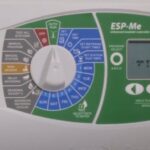
Newer innovations in lawn sprinkler technology include “smart” irrigation controllers. These controllers calculate when to water the landscaping by monitoring online weather data via your wi-fi network. You still have to program them to coincide with the weekly watering restrictions. They are not autonomous.
Unless you are the kind of person that pays no heed to your yard or its watering needs, I do not believe they save as much water as manufacturers claim. By visually paying attention to your turf or indicator plants I think you can save more water than smart controllers.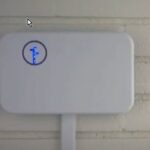
Simply turn off your sprinkler timer until you see water stress in your yard. When you see stress turn the timer to Auto. It will water on the next scheduled day. When that water day is over, turn the controller off until your landscape exhibits water stress again. But, if that’s too much trouble you may want to upgrade to a smart irrigation controller.
Doing this will force your turf and plants to send their roots deeper into the soil to look for moisture. Deeper roots equal more drought tolerant plants.
Types of Lawn Sprinkler Heads
When discussing how long to water grass, you must first discuss what type of sprinklers you will be using as the runtimes to achieve sufficient water distribution vary by type. There are four basic types of sprinkler heads:
Spray Heads
Spray heads distribute water in a fixed pattern. They do not rotate or move. The nozzles come in many patterns, but for discussion purposes the basics are 90-degree, 180-degree and 360-degree. All employ what is called “matched precipitation” which means the water
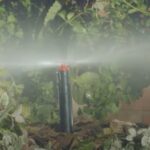
output matches the area covered. Generally (fluctuates based on pressure, etc.) a 15 foot 90-degree spray nozzle delivers around one gallon per minute.
A 15 foot 180-degree nozzle delivers around 2 gallons per minute. This “matches” because the 2 GPM nozzle covers twice as much area as the 1 GPM nozzle. Likewise, the 360-degree nozzles deliver 4 GPM, twice as much as the 180-degree and four times as much as the 90-degree due to the size of the area it covers is four times as large.
Rotor Heads
Rotor heads are so named because they rotate back and forth. The nozzles are interchangeable to fit or “match” the water distribution of the 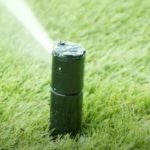
If you place a 2 GPM nozzle in a rotor covering 90-degrees, then a 180-degree nozzle would be 4 GPM and so forth.
Stream Nozzles
Stream nozzles like Hunter MP Rotators and the Rainbird R-Van’s are heralded as the “new” type of nozzle. Really? Thirty-five years ago, I was installing Toro 300 stream rotors all over Atlanta. Stream rotors are not new, but the fact that you can convert a spray to a stream rotor is. This is very convenient as it makes converting mixed spray and 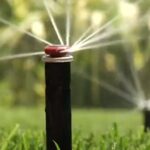
Drip Sprinklers
Drip irrigation often must run for well over and hour to adequately water the shrubs and landscape plants. Generally subsurface drip is not used on turf due to poor lateral water movement and root intrusion.
Irrigation engineers are addressing these problems and hopefully soon your grass can be watered via drip as well. In 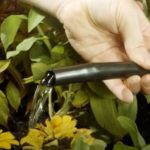
This is incorrect design as the landscape watering cannot be turned off unless the turf rotors are turned off. This is a problem when for example replacing all the shrubs. New plants need daily watering, but established turf does not.
This sprinkler system design flaw will continue to be a problem until County building code regulators decide to step in and act. Don’t hold your breath.
How to Uniformly Water Your Grass
First, we need to define the term: uniformity is how evenly the sprinklers apply water over their intended target area, often expressed as Distribution Uniformity Lowest Quarter or DULQ.
The number one problem that I see evaluating residential systems (I do irrigation repair for a living) is the mixing of sprinkler heads with different precipitation rates. I see this a lot when performing sprinkler repair in Longwood FL. Mostly the mixing of sprays and rotors, but also using the wrong nozzles in rotors.
If you look at a spray nozzle chart, you will see that the precipitation rate for a fifteen-foot 180 degree nozzle is 1.83 inches per hour at 30 PSI.
If you look at a Hunter rotor nozzle chart, a “two gallon per minute” nozzle (#6) is .33 inches per hour. If we divide 1.83 by .33, we see that the spray nozzle applies about five and a half times as much water per hour (or per minute, it is the same differential) as the rotor.
So, if we mix these two different heads on one zone either the area covered by the spray nozzle gets too much if timed correctly for the rotor, or the area watered by the rotor gets too little if correctly programmed for the spray.
The other common problem is the installation of rotors that water different size areas all with the same size nozzle. If you use a 2 GPM nozzle that rotates 90-degrees, the 360-degree rotor must be an 8 GPM nozzle to be uniform or equal.
In fact, I would guess that most residential rotor zones I see are installed this wrong way. Why? Speed of installation and lack of worker training. You can buy cases of rotors with pre-installed nozzles, usually 3 GPM.
So rather than take the time to install the system correctly by knowing the proper size needed and taking the time to change it, they just make all the rotors the 3 GPM pre-installed ones. Who is going to check them? The building inspector? He/She just makes sure the system has a backflow and rain sensor, if that.
It becomes the homeowner’s problem a few years down the road when their grass is dying and full of weeds, and the sprinkler repairman says “to make it right we gotta split the zone and add a valve to obtain the extra GPM, gonna be $1200 bucks.”
How to Efficiently Water Your Grass
Efficiency when related to irrigation means; what percentage of the water applied makes it to the target root zone. Uniformity affects irrigation efficiency, as does wind, soil run-off, evapotranspiration, etc.
Uniformity can be improved but is mostly set at the time of the design and installation. Efficiency can be more easily improved. One of the easiest ways is to use what is called syringe cycling or “cycle and soak.” This means running the whole irrigation system consecutively for multiple times for less minutes versus once for a longer duration.
So rather than run the sprays for twenty minutes once, run them three times for 6 minutes. Instead of running the rotors for an hour, run them three times for 20 minutes, etc.
On dense soils like clay this helps prevent run-off. On sandy soils in Florida, it helps avoid deep percolation where the water goes past the root zone. The video below explains more:
Irrigation efficiency is expressed as a percentile. It is derived from a lot of factors and can only be accurately determined through a water audit.
Without getting too “mathy”, according to studies done by the University of Florida, most residential irrigation systems are 40 to 50 percent efficient. Using drip irrigation for all non turf areas helps. Installing a smart timer helps. But plan on around 50% of all the water you apply with your automatic sprinkler system to be wasted.
Why can’t irrigation contractors put in a 100% efficient automatic sprinkler system? Because it is impossible. Even outdoor drip barely breaks the 90th percentile and then only if installed by someone who really knows what they are doing, which is not your typical sprinkler laborer.
It is also much more expensive to install highly efficient spray and rotor irrigation. If one contractor says to you “I can put in a highly efficient system for $7000.00” and the next guy says he can put you in a great system for $2500.00, who do you want to believe?
Pro Tip: ask your sprinkler contractor if he can guesstimate roughly, as a percentage, the efficiency of the system he wants to install. If he says, “100 percent efficient!” he is either lying or does not understand the math behind irrigation design. Having taken and passed the same Florida Sprinkler Specialty Contractor test as he has, I would guess the latter. It’s not a hard test.
Now, if you are a “math guy” and want more on the subject you can check out these links:
https://www.irrigation.org/IA/FileUploads/IA/Resources/TechnicalPapers/2009/EvaluationOfUniformityMeasurementsFromLandscapeIrrigationAuditing.pdf
https://www.irrigation.org/IA/FileUploads/IA/Resources/TechnicalPapers/2011/HowEfficientIsLandscapeIrrigation.pdf
https://edis.ifas.ufl.edu/ae144
https://edis.ifas.ufl.edu/lh025
When to Water Your Grass
Sorry, no easy answer, as every yard is different. If you want to be very accurate, combine inground moisture meters with smart controller weather data and be done with it. Your lawn will water itself.
Next best option is visual inspection. Look for folding leaves in your turf blades or use the “step method.”
Go to an area of your lawn that receives no shade, or the least shaded part of your yard. This is the grass that will get dry first. Step on it heavily with your whole weight. If your footprint is gone in 3 seconds or less the tuft does not need water. If after 3 seconds you can tell your shoe size, water on your next legal water day.
The worst option is to leave it up to your analog rain sensor. They are not installed with any accuracy other than being set to ¾ of an inch. Where they are placed has a lot to do with how well they work. To work properly they have to be “dialed in” over time. Since it is probably attached to your roof and you need a ladder to reach it, we both know that ain’t gonna happen.
To make it more likely that you will adjust the rain sensor over time, use a wireless one and place it where you can easily reach and adjust it.
For your shrubs you can put in some water indicator plants like azaleas
Finally, “How Long to Water Grass?”
Again, no easy answer, as soils are different, and every yard is different. Even soils in the same neighborhood can be very different.
The area where your house sits used to be natural woods. It had a very predictable soil profile. When the bulldozers came, they churned that soil profile like a mixing bowl. The sand, lime, loam and clay are no longer distributed in any order.
Some neighborhoods in Florida are built on elevated land from the retention ponds that were built for them. There are irrigation systems in Sanford FL that I’ve worked on that are rock hard grey clay instead of the natural sand that should be there. The point being is there is no “one size fits all” when it comes to watering your lawn.
But I will share with you what I do. When I’m evaluating someone’s lawn in Florida, I look at how the different zones cover different areas due to shade, wind blockage from trees and buildings and turf versus shrub percentages.
Because you need to water long enough to satisfy the driest area on the zone (see DULQ above), and since 9 out of 10 lawns in Florida have sandy loam soil, I set the zone times like this:
Rotors in full sun one hour. Sprays in full sun twenty minutes. Rotors in full shade thirty minutes. Sprays in full shade ten minutes. Drip I turn off unless it waters flowers, because unless the shrubs contain water indicator plants, established shrubs do not need supplemental watering.
On clay soil which I used to work with in Atlanta I would setup run-times as: Rotors full sun 10 minutes. Sprays full sun three minutes. Cycle soak as necessary.
Final Thoughts on How Long to Water Grass
All though this goes against my financial interests as an irrigation repair person, you could just skip the whole “how long to water grass” thing and just ditch the lawn. I used to have a house in St Pete beach with a white rock yard. It had very colorful plants around the house foundation. I thought it looked quite nice and the plants and rocks never needed watering.
I don’t know about other areas of the country, but in Florida your Homeowners Association cannot stop you from having a water friendly yard. This is the Florida-friendly landscaping statute F.S. §373.185.
To what extent you can take that I don’t know, but this is what the Florida Bar Association says. Just thought you might want to know.



